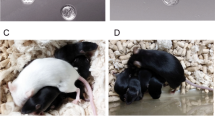Abstract
Purpose
Our purpose was to find a medium to enhance mouse zygote development and, hopefully, to apply the results to a coculture system and to enhance the ART pregnancy rate.
Design
The study was designed to compare different media's support of mouse zygote development with/without serum supplement. The outcome measure was the percentage of mouse zygotes/embryos that developed to the expanded blastocyst and hatchout stage.
Results
(1) Using human tubal fluid (HTF), one-cell zygotes had a 34.6±5.2% (mean±standard deviation) development rate, and two-cell embryos a 86.5±3.2% development rate. (2) Minimum essential medium alpha (MEM) showed the best results (52.2±14.5%) among Ham's F-10 (19.1±6.3%), HTF (26.8±8.2%), NCTC-135 (38.8±12.6%), MEM with nuclei acid (24.6±10.0%), and Dulbecco's modified Eagle medium (28.0±20.2%). (3) With the serum supplement, there was no significant difference among Ham's F-10 (21.5±23.7), HTF (29.3±10.4%), NCTC-135 (36.5±6.2%), and MEM (38.8±17.9%).
Conclusion
MEM is the best medium among the six media examined. Preliminary study showed that MEM gave a good clinical pregnancy rate (29%).
Similar content being viewed by others
References
Dandekar PV, Glass RH: Development of mouse embryos in vitro is affected by strain and culture medium. Gamete Research 1987;17:279–285
Quinn P, Kerin JF, Warnes GM: Improved pregnancy rate in human in vitro fertilization with use of a medium based on the composition of human tubal fluid. Fertil Steril 1985;44:493–498
Rosner B: Fundamentals of Biostatistics, 3rd ed. MA: PWS-Kent, 1990
Ham RG: An improved nutrient solution for diploid Chinese hamster and human cell lines. Exp Cell Res 1963;29:515–526
Morton HJ: A survey of commercially available tissue culture media. In Vitro 1970;6:89–108
Chatot CL, Ziomek CA, Bavister BD, Lewis JL, Torres I: An improved culture medium supports development of random-bred 1-cell mouse embryos in vitro. J Reprod Fertil 1989;86:679–688
Chatot CL, Tasca RJ, Ziomek CA: Glutamine uptake and utilization by preimplantation mouse embryos in CZB medium. J Reprod Fertil 1990;89:335–346
Carney EW, Bavister BD: Stimulatory and inhibitory effects of amino acids on development of hamster eight-cell embryos in vitro. J Vitro Fertil Embryo Transfer 1987;4:162–167
Schini SA, Baviester BD: Two cell block to development of cultured hamster embryos is caused by phosphate and glucose. Biol Reprod 1988;39:1183–1192
Bae IH, Foote RH: Carbohydrate and amino acid requirements and ammonia production of rabbit follicular oocytes matured in vitro. Exp Cell Res 1975;91:113–118
Petters RM, Johsson BH, Reed ML, Archibong AE: Glucose, Glutamine and inorganic phosphate in early development of the pig embryo in vitro. J Reprod Fertil 1990;89:269–275
Kane MT, Carney EW, Bavister BD: Vitamins and amino acids stimulate hamster blastocysts to hatch in vitro. J Exp Zool 1986;239:429–432
Kane MT, Bavister BD: Vitamin requirements for development of eight-cell hamster embryos to hatching blastocyst in vitro. Biol Reprod 1988;39:1137–1143
Bavister BD, Arlotto T: Influence of single amino acids on the development of hamster one-cell embryos in vitro. Mol Reprod Dev 1990;25:45–51
Loutradis D, John D, Kiessling AA: Hypoxanthine cause a 2-cell block in random-breed mouse embryos. Biol Reprod 1987;37:311–316
Nureddin A, Epsaro E, Kiessing AA: Purine inhibit the development of mouse embryos in vitro. J Reprod Fertil 1990;90:455–464
Noda Y, Matsumoto H, Umaoka Y, Tatsumi K, Kishi J, Mori T: Involvement of Superoxide radicals in the mouse two-cell block. Mol Reprod Dev 1991;28:356–360
Noda Y: Embryo development in vitro. Assist Reprod Rev 1992;2:9–15
Cross PC, Brinster RL: The sensitivity of one-cell mouse embryos to pyruvate and lactate. Exp Cell Res 1973;77:57–62
Author information
Authors and Affiliations
Rights and permissions
About this article
Cite this article
Wun, W.S.A., Wun, C.C.C. & Grunert, G.M. Minimum essential medium alpha (MEM) enhances assisted reproductive technology results. I. mouse embryo study. J Assist Reprod Genet 11, 303–307 (1994). https://doi.org/10.1007/BF02215717
Received:
Accepted:
Issue Date:
DOI: https://doi.org/10.1007/BF02215717




